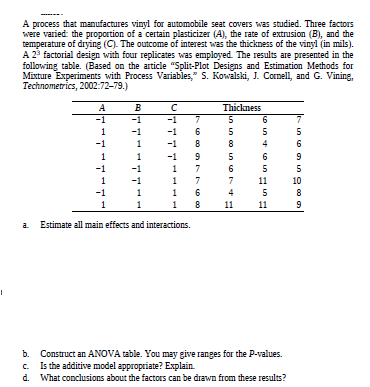A process that manufactures vinyl for automobile seat covers was studied. Three factors were varied: the proportion of a certain plasticizer (A), the rate of extrusion (B), and the temperature of drying (C). The outcome of interest was the thickness of the vinyl (in mils). A 23 factorial design with four replicates was employed. The results are presented in the following table. (Based on the article "Split-Plot Designs and Estimation Methods for Mixture Experiments with Process Variables," S. Kowalski, J. Conell, and G. Vining, Technometrics, 2002:72-79.) в Thickness -1 -1 -1 -1 -1 -1 -1 -1 11 10 -1 11 11 a Estimate all main effects and interactions. b. Construct an ANOVA table. You may give ranges for the P-values. Is the additive model appropriate? Explain. d. What conclusions about the factors can be drawn from these results?
A process that manufactures vinyl for automobile seat covers was studied. Three factors were varied: the proportion of a certain plasticizer (A), the rate of extrusion (B), and the temperature of drying (C). The outcome of interest was the thickness of the vinyl (in mils). A 23 factorial design with four replicates was employed. The results are presented in the following table. (Based on the article "Split-Plot Designs and Estimation Methods for Mixture Experiments with Process Variables," S. Kowalski, J. Conell, and G. Vining, Technometrics, 2002:72-79.) в Thickness -1 -1 -1 -1 -1 -1 -1 -1 11 10 -1 11 11 a Estimate all main effects and interactions. b. Construct an ANOVA table. You may give ranges for the P-values. Is the additive model appropriate? Explain. d. What conclusions about the factors can be drawn from these results?
Holt Mcdougal Larson Pre-algebra: Student Edition 2012
1st Edition
ISBN:9780547587776
Author:HOLT MCDOUGAL
Publisher:HOLT MCDOUGAL
Chapter11: Data Analysis And Probability
Section11.4: Collecting Data
Problem 6E
Related questions
Question

Transcribed Image Text:A process that manufactures vinyl for automobile seat covers was studied. Three factors
were varied: the proportion of a certain plasticizer (A), the rate of extrusion (B), and the
temperature of drying (C). The outcome of interest was the thickness of the vinyl (in mils).
A 23 factorial design with four replicates was employed. The results are presented in the
following table. (Based on the article "Split-Plot Designs and Estimation Methods for
Mixture Experiments with Process Variables," S. Kowalski, J. Conell, and G. Vining,
Technometrics, 2002:72-79.)
в
Thickness
-1
-1
-1
-1
-1
-1
-1
-1
11
10
-1
11
11
a Estimate all main effects and interactions.
b. Construct an ANOVA table. You may give ranges for the P-values.
Is the additive model appropriate? Explain.
d. What conclusions about the factors can be drawn from these results?
Expert Solution
This question has been solved!
Explore an expertly crafted, step-by-step solution for a thorough understanding of key concepts.
This is a popular solution!
Trending now
This is a popular solution!
Step by step
Solved in 4 steps with 14 images

Recommended textbooks for you

Holt Mcdougal Larson Pre-algebra: Student Edition…
Algebra
ISBN:
9780547587776
Author:
HOLT MCDOUGAL
Publisher:
HOLT MCDOUGAL

College Algebra (MindTap Course List)
Algebra
ISBN:
9781305652231
Author:
R. David Gustafson, Jeff Hughes
Publisher:
Cengage Learning


Holt Mcdougal Larson Pre-algebra: Student Edition…
Algebra
ISBN:
9780547587776
Author:
HOLT MCDOUGAL
Publisher:
HOLT MCDOUGAL

College Algebra (MindTap Course List)
Algebra
ISBN:
9781305652231
Author:
R. David Gustafson, Jeff Hughes
Publisher:
Cengage Learning
